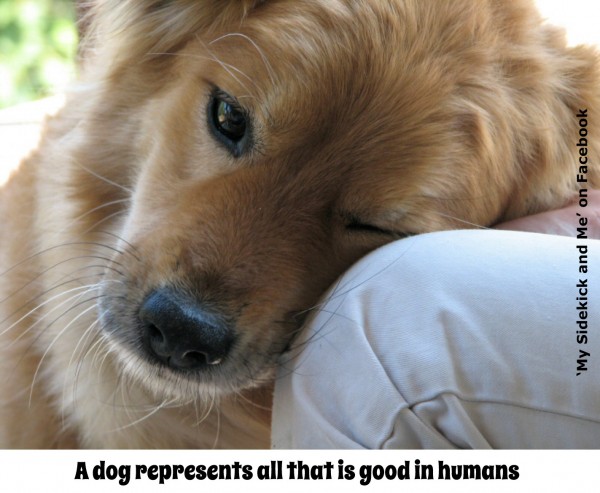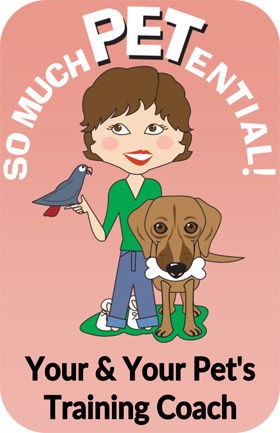Pets
Are Parrots Difficult Pets?
NOTE: I have a new pet behavior blog located at http://www.SoMuchPETential.com/blog. Thanks!
In a recent issue of online Good Bird Magazine, president of Good Bird, Inc. and internationally recognized trainer and consultant Barbara Heidenrich offers a great answer to the question…
Are parrots difficult pets?
“In my experience parrots are neither inherently good companion animals nor inherently bad companion animals. The behaviors parrots choose to exhibit are the result of what earns them reinforcers or what will cause an aversive 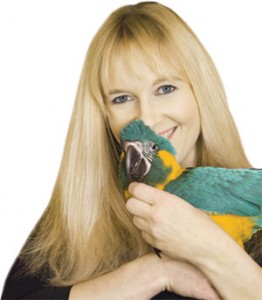 stimulus to go away. In other words, parrot behavior is the result of our behavior. If we choose to reinforce behaviors we like, we will see those behaviors exhibited more often. If we try to control parrots through unpleasant experiences we are likely to create agressive behavior or fear responses.
stimulus to go away. In other words, parrot behavior is the result of our behavior. If we choose to reinforce behaviors we like, we will see those behaviors exhibited more often. If we try to control parrots through unpleasant experiences we are likely to create agressive behavior or fear responses.
The bottom line is parrot caregivers who are armed with tools and information on training their parrots with positive reinforcement are likely to have great sucess with a parrot in their home. Those who rely on coercion are sure to encounter problems and sadly miss out on the incredible relationship based on trust once can have with a parrot. The methods we choose to influence parrot behavior determine the outcome, not the genetics of the parrot.”
Barbara Heidenrich has been a professional in the field of animal training since 1990. She is president of Good Bird Inc. providing parrot behavior and training products. Barbara also consults on animal training in zoos and other animal related facilities. She is past president of the International Association of Avian Trainers and Educators.
Enriching Your Parrot’s Environment
NOTE: I have a new pet behavior blog located at http://www.SoMuchPETential.com/blog. Thanks!
I was looking at Barnaby’s cage the other day and it occurred to me, there are some ‘toys’ in there that he hasn’t touched. He definitely looked like a little, mischievous guy who needed more to do with his time. So I refilled the adding machine paper roll 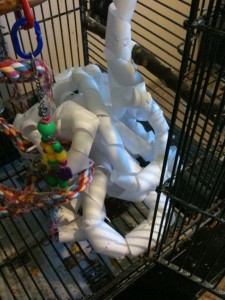 holder, wrapped newspaper around the bars and filled an old sock with food.
holder, wrapped newspaper around the bars and filled an old sock with food.
Guess what I found when I returned? A huge pile of adding machine paper on the cage floor, shredded newspaper, and an old sock with huge holes in it.
Yep, I’m figuring it is about time for a reminder about the importance of making our parrots’ environments enriching.
Remember, these are animals that would spend hours every day in the wild searching for food, flying, raising young, or watching out for predators. We take them into our homes, put them in cages and want them to be quiet, non-destructive inhabitants.
They rely on us to not only provide them with safety and nourishment, but also to keep them busy and stimulated. And, if we let our birds down by not providing them these basic needs, then who can we ‘really’ blame if our pets develop behavior issues.
Robin Shewokis, owner of the Leather Elves who helps zoos and other facilities create enriching environments, once told me some considerations to keep in mind are: knowing your bird’s natural history (for example, cockatiels are ground foragers so putting foraging activities high in a cage isn’t the best idea); providing activities that stimulate as many senses as possible; and knowing your specific bird (because really behavior is individual) so that you can give him activities he will interact with. (Remember you can also teach a bird to interact with something – and training is a great enrichment activity for both you and your pet.)
For example – I know Barnaby loves to hang upside, loves to try and figure things out, he chews some especially paper, and he loves bells. When his cage door is open he spends a lot of time hanging upside down from his toy hanger attached to the cage.
So, inside his cage, I have a number of bells. There are beads strung (with knots in between) on hemp string and tied around his cage, paper rolls, food in different bowls, etc. On the bottom of his cage I have a human baby toy that is a cup with a mirror on the bottom which is hung from the bars and filled with some pellets. Many days I find just crumbs so I know he is busy exploring.
Keep in mind, enrichment does not have to be super expensive. I always tell the story of the time I bought $50 worth of toys online. When I opened the box, the first thing Barnaby grabbed was the receipt page…and he played with it for 10 minutes!
Be creative and have fun, but also please keep safety in mind.
Link to great enrichment activity book.
Animal Training Using Shaping
NOTE: I have a new pet behavior blog located at http://www.SoMuchPETential.com/blog. Thanks!
Have you ever ‘shaped’ behavior? Sure you have. We all have. If you’ve ever taught a child to talk, write or tie a shoe, you shaped that behavior. If you’ve ever learned to sing or play an instrument, you didn’t begin by playing Bach. If you’ve played baseball, you had to learn how to hit a home run. Your skill set was shaped.
Shaping is behavior science strategy for teaching behaviors by breaking that final ‘target’ behavior down into smaller increments known as successive approximations and reinforcing the animal at each incremental step until the final target behavior is learned.
I love using shaping to teach my pets new behaviors because it is so much fun for both of us – fun for me to challenge myself in being the best teacher I can be and fun for them in trying to figure out the ‘game’ or what it is they need to do to earn the reinforcement from me.
What are other benefits of using shaping?
You can teach your pet a behavior that he otherwise may find very confusing such as when I taught Sam to take a bow or scratch his nose. (the things we get our pets to do)
You can fine-tune a behavior your pet is already doing such as teaching Sam to stay sitting for longer periods of time.
You are encouraging your dog to offer new behaviors, try new things and think out of the box to solve problems.
So, how does it work? Here are some basic steps:
Identify the final behavior you want to teach.
Identify your reinforcers for each approximation. Know which reinforcers are of the highest value. As you progress in difficulty and distractions, you may need to increase the value of your reinforcers that you are offering.
Make a plan that lists all of the closest approximations to the final behavior. The first approximation may or may not be even remotely related to the final behavior.
(Optimally begin in an environment with minimal distractions.) Teach each approximation with positive reinforcement and once performed without hesitation, move on to the next approximation and repeat the process until the final behavior is achieved.
Notes:
It’s good to use a marker or bridge when the approximation is offered, followed by the reward because you more than likely would not be able to give the reinforcer to your pet quick enough to reinforce that specific behavior without a bridge. The marker can be a clicker or it can be a word such as ‘good.’ You will need to first teach your pet association between the marker – conditioned reinforcer – and the treat before using the marker in training of other behaviors.
When teaching new behaviors, reinforcers need to be given immediately after the behavior (approximation) and every time.
Size of approximations matters. If your steps in your plan are too small, your learner may satiate on the reinforcer too quickly and may not be interested in the training. If your steps are too big, it may become too difficult to understand and your learner may lose interest. There is no magic formula here. This is where the fun comes in – for you to figure out how big or small to make your steps and adjust along the way by the feedback your animal is giving you; and for your animal in trying to figure out what you want him to do to get his reinforcement.
If your animal is not learning what you want him to learn, instead of shrugging it off to his being dumb or stubborn, take that as feedback from your student that you need to change your lesson plan.
Shifting to the next approximation. There are several ways – one is to observe the tiny variation in which your pet does an approximation and reinforce the one that is closest to the final behavior. Another way is to withhold the reinforcement for the current approximation and wait until your pet tries to figure out what he needs to do next to get that piece of cheese or whatever your reinforcement is. CAUTION that the second way can set the occasion for some frustration so try to be a better observer and go with the first way!
Below is a video of Canadian assistance dog trainer Donna Hill teaching her dog to move a light switch.
A Dog Brings Out Our Best
Pet First Aid Classes Offer Important Information
NOTE: I have a new pet behavior blog located at http://www.SoMuchPETential.com/blog. Thanks!
Our pets are like our children. And, like kids pets can have accidents, ingest things they shouldn’t or have wellness issues.
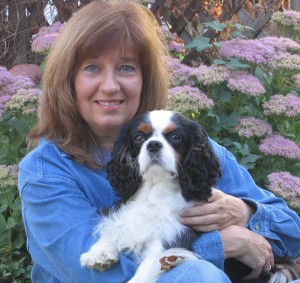 As a successful pet sitter, Darlene Ehlers has seen all kinds of situations and she has watched over sick animals or animals with disabilities. She knows how important first aid knowledge is to our furred friends, which is why she trained and became a certified Pet Tech First Aid instructor.
As a successful pet sitter, Darlene Ehlers has seen all kinds of situations and she has watched over sick animals or animals with disabilities. She knows how important first aid knowledge is to our furred friends, which is why she trained and became a certified Pet Tech First Aid instructor.
Through her business Tri State Pet First Aid, she educates others too. Darlene has a four-hour basic class and an eight-hour Pet Saver class for both pet owners, caretakers and trainers. Note that these classes are geared to health and wellness of cats and dogs.
In Pet Saver, participants learn about restraining and muzzling, rescue breathing, canine and feline CPR, chocking management, bleeding and shock management, snout-to-tail assessement, assessing a pet’s vitals, treating for insect bites and stings, heat and cold injuries, what to do if your pet has a seizure, caring for a senior pet, and dental care.
Her next Pet Saver class is this coming Saturday, July 14. Registration is $119 and you must register no later than Friday, July 13. For future classes, please visit her site…http://www.tristatepetfirstaid.com/


